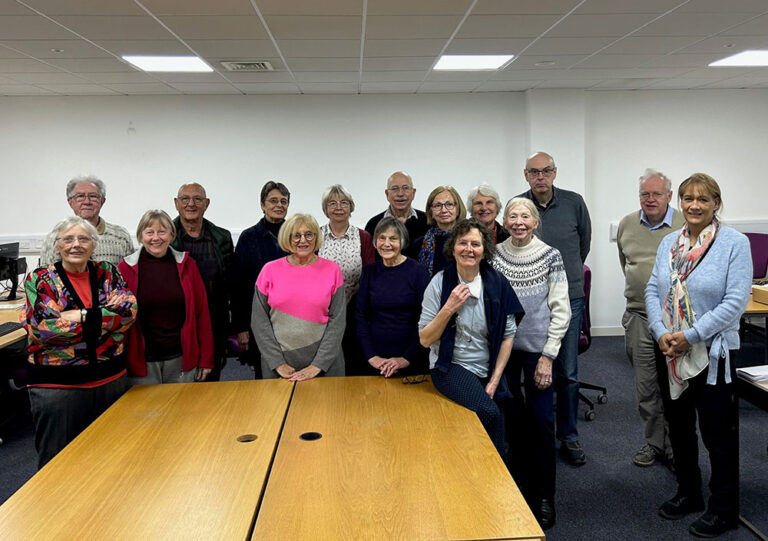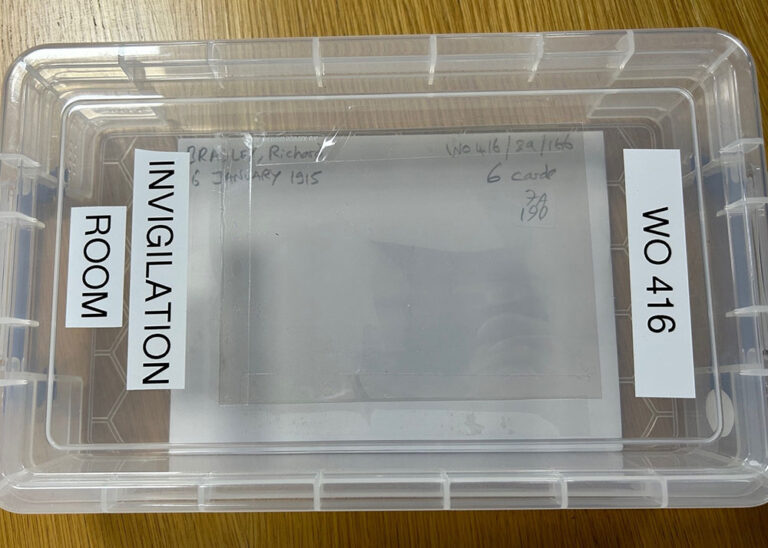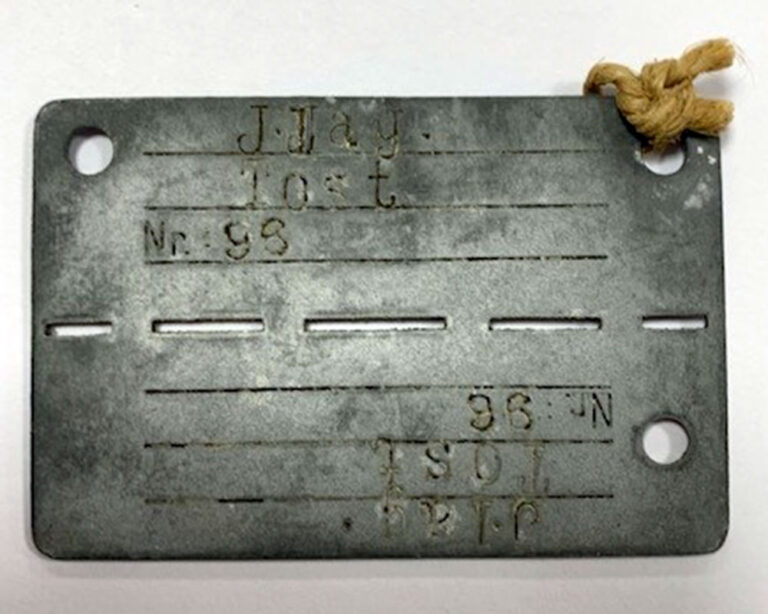Over five years ago, in January 2018, I wrote a blog about a group of our dedicated Tuesday onsite volunteers working on creating access to some newly transferred 417 boxes in the series WO 416. These contained tens of thousands of personnel cards for British and Allied prisoners of war and civilian internees captured in German-occupied territory during the Second World War.
Together the volunteers have catalogued personal history cards for over 200,000 individuals. They have also removed staples attaching cards together and rehoused the cards from large, unsorted boxes, into separate secure archival envelopes. In the process, they painstakingly numbered each and every envelope, recording summary details.

I am delighted to say that the project is now complete and because of the huge efforts of the 20 Tuesday volunteers, the National Archives has been able to make available all records for individuals born more than 100 years ago.
Only 7.5% of the collection now remains closed, and each year, until 2028, the vast majority of these records will become open as the dates of birth of the subjects exceed 100 years. Only a handful of cards will remain closed longer and these relate to civilians born as late as 1934 and interned as children.

Nearly six years on, the project itself has taken longer than the Second World War in Europe did to finish but that is by no means a criticism. The records are in German and it was not always easy to capture the personal details that enable research from a multitude of users from genealogists to social, medical and military historians. The volunteers were tasked to retrieve the following information:
- Main Camp name (Gefangenenlager) – prisoners of war would be moved to a number of camps during their period of confinement).
- Camp number (Gefangenen Nummer)
- Country of origin
- Surname (Name)
- First name/s (Vorname)
- Place and Date of birth (Geburtstag und Ort)
- Date and Place of Capture (Gefangenname – Ort und Datum)
- Date of death (if applicable)
- Service (e.g. Army, Air, Navy, Civilian) (Truppenteil)
- Service rank (Dienstgrad)
- Service number (Matrikel Nummer)
In many cases, some of these details were missing, so volunteers would need to check other reliable sources such as the Commonwealth War Graves Commission. Other records in the custody of the National Archives such as the 1939 National Register helped verify dates of birth. Information gleaned from other sources are added to item descriptions in square brackets.
Many cards were misfiled and if these were found in the same box then every effort was made to marry these up as one record, though inevitably some records for the same individual were scattered among different boxes. Take the example of James Thomas’ records – filed under both the surname Thomas, James and James, Thomas.

The biggest delay and frustration to the project was COVID which stopped so many things in its track for all of us in 2020 and 2021. As the records contained personal details of living people they couldn’t be scanned to be worked on securely from home. They had to be catalogued onsite using the original records in a secure area. For many months, the volunteers were not able to come onsite as we were all told to stay at home.
When restrictions lifted, volunteers could return but social distancing meant that they could no longer work as a group of 20. Instead for much of 2020 and 2021 they committed monthly, rotating in groups of five each week. Nevertheless, they remained focused and determined to see the project to its conclusion.
Project complete, the data can be fully searched and analysed on our catalogue, Discovery.
Open items contain full enriched descriptions capturing information described above, but the 15,000 closed record descriptions only record full name and year of birth. Closed records can be opened early if an acceptable proof of death is provided. Instructions of how to do this are explained on Discovery.
Of the 185,000 opened records, 100,000 relate to British Army personnel, 5,200 to Australian forces, 2,800 to New Zealand forces, and 4,600 to South African forces.
26,000 were RAF personnel, hundreds of whom never actually became prisoners of war – their bodies were found and records were created from the details found by the captors – usually from their dog tags. 2,500 relate to Royal Navy personnel, 3,700 to those serving with the Merchant Navy and there are cards for over 4,000 civilians, such as teachers, journalists, gardeners, and businessmen.
Regardless of their occupation, there are nearly 3,500 individual records for those with the surname Smith and over 1,200 of the 200,000 were born in Hull!

The number of cards vary for each person and there are a number of different types of cards. The main personnel card usually includes a photograph and a fingerprint. As well as details about their military career, they also include information about civilian employment, religion, and next of kin. Other cards include pink cards which signify hospital patient cards, detailing why prisoners would need medical attention. Other cards signify transfer from one camp to another.
What is very clear is that these cards have been dispersed across the globe. All cards would have been taken into allied control when the camps were liberated in the Spring of 1945. However, some cards would be detached to form part of a serviceman’s military record and others would work their way back to other Commonwealth nations, and, ultimately, overseas national archives.
By and large, we do appear to have at least one card for the vast majority of British and Commonwealth personnel. A good example of this is examining the records of the 76 men who escaped from Stalag Luft on 25 March 1944, in what became known as the Great Escape. The Escape involved a multitude of nationalities including British, Canadian, Australian, New Zealander, Norwegian, Czech, Polish, Argentinian, South African, French, Belgian, Dutch and Lithuanian. Of the 76 successful escapees, 73 were recaptured, most within several days of the breakout, 50 of whom were executed. WO 416 contains a record of 73 of the 76 escapees.

The completion of the project means that we can now consider the digitisation of the collection which ultimately will allow researchers to search and download records in one transaction from anywhere in the world. Given that this is a global collection, this would be of huge benefit to researchers.
In the meantime, we will continue to open up some of the stories volunteers have unearthed and match them up with other collections, to get a better understanding of what life was like ‘behind the wire’. If you’d like to read some of these stories, check out these blogs.
Learn more about volunteering at The National Archives
Find out more
Find out more about Second World War internment and POW records at our free exhibition Great Escapes: Remarkable Second World War Captives. Opening Friday 2 February 2024, Great Escapes explores the human spirit of hope and resilience during times of captivity, revealing both iconic and under-told stories of prisoners of war and civilian internees during the Second World War.
We’ve also scheduled a season of special events to accompany the exhibition that are available to book now.
This project is dedicated to Tuesday volunteers Susan Dutch and Diane Rowland who have both sadly passed away. Both were a key part of the WO 416 project and unearthed some fascinating stories in doing so. Read Diane’s 2018 blog on cards relating to the Guinea Pig Club.
Wow. Thank you for never giving up on getting these projects moved along. AND, for posting these milestones on Twitter for me to be notified!
Magnificent work by all your volunteers, unsung heroes, who help so many people. I got my late dads POW records during/after covid, and found out so much about my late dad I never new about. His time in stalag 8B was never spoken of, or the work camps he was sent to. To mention anything about the war was taboo, so I never new anything about what happened. After I emigrated to Australia I never had the chance to see him again before he died, so never managed to ask him about it man to man, but after doing my own research on my family tree, i decided to see what i could about his WW2 POW life, and thankfully with the work performed by your magnificent staff and volunteers i managed to locate his records, and get a copy emailed to me here in Australia. thank you all so much. All the best Dave.
These volunteers are heroes too, giving up years of their own free time. Not even allowing a global pandemic to stop them finishing this project, they are selfless as this work was ultimately for the benefit of others searching for details of their family during the war. I am in awe at their utter determination to see this project through to the end, bravo!
Congratulations on this tremendous achievement and many thanks indeed for all your valuable hard work over so many years. Many will be in your debt.
The Online Memorial and Museum of Prisoners of War.
http://www.prisonersofwarmuseum.com
Registered charity no. 1200975
Thankyou all so much for your wonderful dedication and hard work.
My father Rifleman Henry Dawkins, B Company, 2nd Bn, KRRC, was captured at Calais on 26th May 1940, after the 4 day, intense and heroic stand defending the city at the time of the Dunkirk evacuation. Interestingly, his CO was Brigadier General Claude Nicholson, captured the same day, who’s POW card is illustrated above. Sadly, Nicholson died in captivity in 1943. My father survived 5 years as a POW.
A huge well done to the amazing volunteers who made this incredible project possible 👏
I was very glad to see a card for my uncle Alan Lever! I look forward to seeing them digitized.
Kudos to you all for sticking to this work. Having worked as a librarian myself for 32 years, 2 of those as a cataloguer, I fully appreciate the detailed labor involved.
Great work but a transcription error on the following chap (my biography of him was published in 2021). His place of birth is NEATH.
https://discovery.nationalarchives.gov.uk/details/r/C17855248
WOW I never even thought of all the hard work that has gone into all the records in order for us to get them for free. What an absolute awesome gift you and your team have given all us that obtain the records of our Ancestors. Thank you so very much for all your hard work I truly appreciate it.
Absolutely fantastic work thankyou 👏
My Dad Charles Jinks
Captured Boulogne 1940
POW 5yrs you’ve done him & all POW’s
a proud service
Thank to both the Tuesday Team for their incredible hard work and Robin Kershaw for this and the initial blog about the WO 416 series.
Because of the efforts of one and all, I not only discovered the series but now make it a regular port of call whenever I wish to find out about a RAF or Commonwealth airman.
Without the series so many more stories of wartime loss would forever (pun intended) disappear into thin air.
Our thanks to all the volunteers for their dedication in presenting these files.
My wife and I have searched unsuccessfully for any record of her father:
The serviceman in question is: Private G.A.G. Jenkins (Gwyn Alwyn George Jenkins)
> 3rd Battalion,
> The Parachute Regiment Army Air Corps
> service number 2185990
> POW from 26/09/1944 to 20/04/1945
> POW number 91527 Stalag XII-A
> The POW records we have were obtained from “Ancestry” records posted some years ago however these are only a basic record and we would appreciate your comment or advice as to why his more detailed record may not appear within those recently released by your research group.
Thanking you again for all your work and dedication
You’re very welcome. Sometimes not all information is available, but if you know the POW number, that tends to be the most reliable field to search. In this instance the cards don’t reveal two of Private Jenkins’ three forenames, but he does appear: https://discovery.nationalarchives.gov.uk/details/r/C16965110